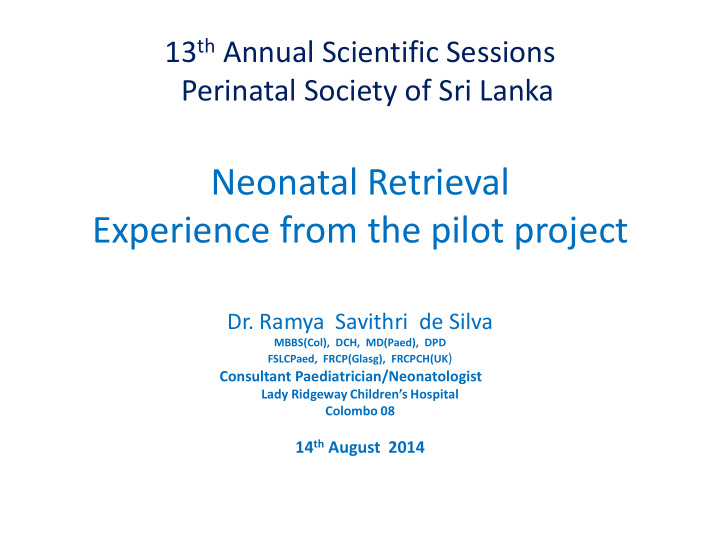



13 th Annual Scientific Sessions Perinatal Society of Sri Lanka Neonatal Retrieval Experience from the pilot project Dr. Ramya Savithri de Silva MBBS(Col), DCH, MD(Paed), DPD FSLCPaed, FRCP(Glasg), FRCPCH(UK ) Consultant Paediatrician/Neonatologist Lady Ridgeway Children’s Hospital Colombo 08 14 th August 2014
Sri Lanka over time 20 15 2008 10 2012 5 0 Infant Neonatal Under 5 Source: WHO World Health Statistics 2010 and 2014
Distribution of mortality under 5 in 2008 by mortality category Neonatal 29 day to 365 1 year to 5 years Share of neonatal Distribution of mortality under 5 mortality in under in 2012 by mortality category five mortality has risen over time Neonatal 29 day to 365 1 year to 5 years Source: Calculations based on WHO World Health Statistics 2010 and 2014
Addressing the Millennium Goals Reduce child mortality - Where we are? From the UNDP MDG website “…. the IMR is lower than that achieved by countries considerably wealthier than Sri Lanka” “the MDG child mortality targets are well within reach .” “Future reductions in infant mortality in Sri Lanka will be driven largely by reductions in neonatal mortality, which is considerably more difficult and expensive to attain ”
Post – Millennium Development Goals • Disability-free survival • Human capital • Sustainable development
Case for a neonatal Transport Service • Regular audits expressed concern about poor condition of newborns following inter- hospital transfer • Hypothermia and hypoglycemia being common problems on admission • Some incidents of major catastrophes • No organized/protocol driven/safe methods prescribed for transfer
Why was back transfer identified as important? • Patients are referred to the LRH from all round the country. • LRH only has 5 ventilated cots. Often referrals have to be refused due to lack of cots. • If facilities exist for safely transferring back babies when the acute phase is over, then NICU cots can be released to accommodate more neonates for specialized care. • Feeding mothers have more family support at the local hospital.
Birth of the Neonatal Transport Service • The Perinatal Society of Sri Lanka identified the formulation of a comprehensive neonatal transport system a key priority area in 2013 • Collaboration with Oxford University NHS Trust • Funding from the WHO and UNICEF • Supported by the FHB • Based at the NICU, Lady Ridgeway Hospital • A pilot project for Western Province
Service • Training workshop on the 8 th May 2013 • Transport team - 4 medical officers & 20 nurses trained in house • Dedicated ambulance with a named driver • 8 am to 4pm service 1 st retrieval on 26 June 2013 from Kethumathi Maternity Hospital Panadura
Kethumathi Maternity Hospital, Panadura
Base Hospital Wathupitiwala
Transfers • 60 retrievals • 37 back transfers • Total number of admissions to the unit 267
The First year • June 26 th 2013 to June 26 th 2014 • Total - 267 infants transferred into LRH – Retrieved – 60 infants – Non retrieved – 207 infants – Back transfer - 37 • 60 infants from the non-retrieved group admitted sequentially -selected for analysis
• • : strong presumption against null hypothesis • : low presumption against null hypothesis • : no presumption against the null hypothesis Demographics Retrieved Non retrieved Gestation 32.5 (4.6) 34.4 (4.9)* Mean Birth Weight 1.7 (0.8) 2.1 (0.9)* Values – mean (SD), *p<0.05 The retrieved babies are ‘more at risk’ compared to the non-retrieved group – significant differences in gestational mean and birth weight
Transfer modes prior to Retrieval (In 2012) 180 160 160 140 120 100 84 78 80 63 60 40 20 0 Incubator cot Trolley Hand Incubator cot Trolley Hand
Temperature on admission prior to retrieval pilot project 140 118 120 100 80 64 60 40 20 1 0 Temp <37 37 or above Unrecordable Temp <37 37 or above Unrecordable
Temperature on admission comparison of retrieved and non-retrieved neonates 60 50 40 Below 36.5 30 Above 36.5 20 10 0 Non-retrieved Retrieved
Temperature on admission detailed comparison of retrieved and non-retrieved neonates 37.5 to 39 100% 36.5-37.5 90% 36-36.5 80% 70% 35.5-36 60% 35-35.5 50% 40% 34.5-35 30% 34-34.5 20% 10% 33.5-34 0% Non-retrieved Retrieved
Capillary blood sugar on arrival Retrieved Non infants retrieved infants Blood sugar 104.0 91.4 (average) Number of 0 6 infants with blood sugars <45 mg/dL
Retrieved group • Smaller and more immature neonates (selection bias) • Excellent temperature control • No episodes of hypoglycemia on arrival • No ‘major’ incidents
Peripheral Hospitals • Staff happy -no stress • Less hassle – saves their manpower • Delays minimized • Parents happy – better care for their baby
Challenges • Geographically restricted • Back transfers – not undertaken as yet fully • 60 transfers – long way to go!
Difficulties encountered • Shortage of trained staff – Medical / Nursing • Limited no. of NICU cots • Only from 0800 – 1600 hours • Strained relationships when unstable neonates are not retrieved • Limited to the Western Province
Future • A precedence has been set • Needs to be expanded • Data collection • National Roll out!
Recommend
More recommend